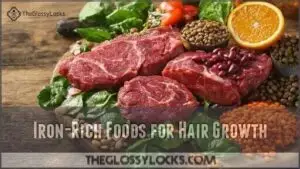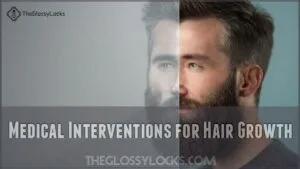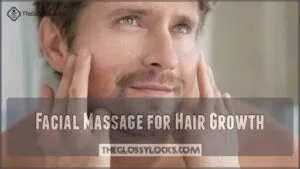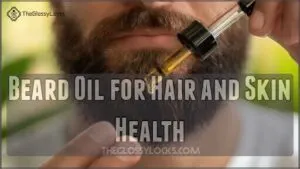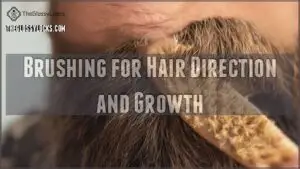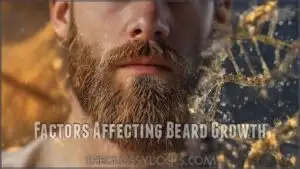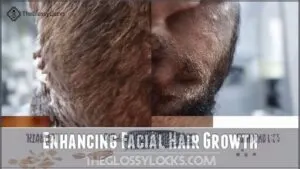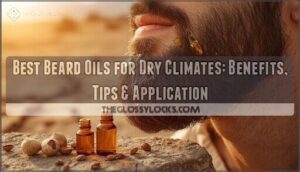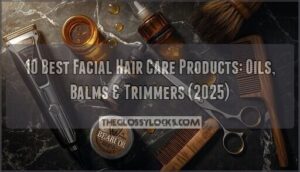This site is supported by our readers. We may earn a commission, at no cost to you, if you purchase through links.

Regular exercise, exfoliating, and getting enough rest can help.
A balanced diet rich in iron, vitamin D, and protein also supports hair growth.
Massaging your face and using a beard brush may encourage growth too.
By incorporating these habits into your daily routine, you’ll be on your way to thicker, healthier facial hair.
Now, let’s explore more ways to boost your beard game and uncover the secrets to achieving the facial hair you’ve always wanted.
Table Of Contents
- Key Takeaways
- Stimulating Facial Hair
- How to Stimulate Facial Hair
- Nutrition for Facial Hair
- Lifestyle Factors for Hair Growth
- Medical Interventions for Hair Growth
- Natural Methods for Hair Stimulation
- Factors Affecting Beard Growth
- Enhancing Facial Hair Growth
- Frequently Asked Questions (FAQs)
- How do you activate facial hair follicles?
- How can I increase my facial hair?
- How to simulate facial hair growth?
- What hormone promotes facial hair growth?
- Can facial hair grow on scar tissue?
- Does age affect facial hair growth rate?
- Are there hair growth supplements for vegans?
- Can certain medications slow hair growth down?
- Does facial hair growth differ by ethnicity?
- Conclusion
Key Takeaways
- You’ll boost facial hair growth by maintaining a balanced diet rich in iron, vitamin D, and protein, which supports hair health and development.
- You can stimulate facial hair follicles by massaging your face, exercising regularly, and using minoxidil, which may help increase density over time with consistent effort.
- You should prioritize lifestyle changes like regular exercise, adequate sleep, and stress reduction to create an environment that supports healthy hair growth and helps you achieve the facial hair you want.
- You’ll need to be patient and consistent with your routine, as stimulating facial hair growth takes time, and it’s essential to track your progress and make adjustments as needed to avoid discouragement and ensure a successful journey.
Stimulating Facial Hair
Growing facial hair faster starts with proper skincare and healthy habits that support your hair follicles.
Start with proper skincare for healthy hair follicles
You can stimulate growth through targeted nutrition, regular face massage, and consistent grooming practices that create ideal conditions for beard development.
Nourish your beard with targeted nutrition and regular face massage for ideal growth conditions
Cleanse and Exfoliate Face
Your face is the foundation for healthy beard growth.
Cleanse twice daily with a gentle, fragrance-free cleanser suited to your skin type. Use lukewarm water temperature to avoid irritation.
Exfoliate 2-3 times weekly to remove dead skin cells that clog hair follicles. Choose exfoliation methods like gentle scrubs or chemical exfoliants.
Many men find benefits using a specialized face wash. Avoid acne cream with harsh ingredients that may hinder growth.
Massage for Blood Flow
Just finished cleansing? Give yourself a moment with face massage techniques. Gentle circles along your jaw and cheeks do more than relax you—they boost blood circulation.
That means stronger growth stimulation for hair follicles, better oil absorption, and, with it, the chance to stimulate beard development. Consistent face massage reveals real circulation benefits for healthy, fuller facial hair growth.
Regular massage can improve blood flow to follicles, which is key for hair growth.
Balanced Diet for Hair Growth
Just like regular massages boost circulation, a balanced diet guards your beard’s well-being.
You want your Protein Intake, Vitamin Sources, and Mineral Importance covered. Healthy Fats and Hydration Effects keep those hair follicles happy.
Think of food as fuel for growth. Try these:
- Lean protein
- Leafy greens for iron and vitamins
- Nuts for healthy fats
- Citrus for vitamin C
- Water
How to Stimulate Facial Hair
Your beard journey is shaped by daily habits and a bit of patience. To kickstart facial hair growth, focus on Follicle Activation and Growth Phases by sticking to a simple routine.
Kickstart your beard growth with patience and a simple routine
It’s not about chasing magic, but turning small actions into results. Recognize that DHT Boosters and increased Receptor Sensitivity can support your coverage and Beard Density.
Brushing and gentle massage can stimulate beard growth by improving blood flow. Scalp massage can also help to halt hair loss.
Every small step helps hair follicles wake up and join the team.
- Massage your cheeks in slow circles to kick off follicle activation and stimulate beard growth.
- Use a gentle brush to direct hair follicles and boost beard density.
- Prioritize beard growth tips centered on Growth Phases for steady progress.
- Apply cold water to increase circulation.
- Don’t skip sleep — growth thrives on rest.
Nutrition for Facial Hair
What you eat has a direct impact on how your facial hair grows.
A balanced diet with vitamins, minerals, protein, and healthy fats gives your hair the nutrients it needs to grow strong and healthy.
Iron-Rich Foods for Hair Growth
Starting with a clean, well-fed system gives your hair follicles the tools they need to thrive.
Iron-rich foods like lean meat, spinach, and beans help boost facial hair growth by supporting hemoglobin. Heme iron absorbs better than non-heme iron, but combining both with vitamin C improves iron absorption.
Watch out for iron deficiency—it can stunt your progress.
Vitamin D for Hair Health
Without enough sun, your body struggles with vitamin D synthesis.
Deficiency symptoms can sneak up—slow facial hair growth or brittle strands may signal you’re low.
Vitamin D, often called the beard growth vitamin D, supports follicles directly.
Try food sources like eggs, oily fish, or fortified milk.
If you supplement, stick to safe supplement dosage guidelines—more isn’t always better, and consider the importance of vitamin D.
Protein-Rich Foods for Beard Growth
Getting enough protein sources fuels facial hair growth by supplying amino acids for keratin production and follicle stimulation.
A healthy diet impacts your beard’s strength and thickness.
Try these protein-rich foods to boost your diet:
- Eggs
- Fish (salmon, tuna)
- Chicken breast
- Beans and lentils
- Greek yogurt.
Consistent, balanced nutrition supports beard growth results.
Saturated Fats for Testosterone Production
You need saturated fats for testosterone production.
Increased SFA consumption is associated with higher testosterone levels.
| Saturated Fat Sources | Testosterone Synthesis |
|---|---|
| Coconut oil | Supports hormone regulation |
| Grass-fed butter | Enhances dietary cholesterol |
| Eggs | Boosts beard growth link |
| Lean meats | Increases testosterone |
Lifestyle Factors for Hair Growth
You can influence your facial hair growth by making a few simple changes to your daily routine.
By exercising regularly, getting enough sleep, and reducing stress, you can create an environment that supports healthy hair growth.
This environment helps you achieve the facial hair you want by allowing your body to function in a state that is conducive to growth.
Regular Exercise for Circulation
To boost facial hair growth, get moving! Regular exercise ramps up circulation. This helps nutrients reach your hair follicles.
Exercise intensity matters. Aim for workouts that get your heart pumping. Think cardio and strength training. Frequency matters too. Try for at least 30 minutes most days.
Exercise can also increase testosterone levels.
- Feel the power of your own body.
- Imagine the confidence a full beard brings.
- Join the brotherhood of the bearded.
Stress Reduction Techniques
You can reduce stress through meditation, breathing exercises, and social support, which helps with beard growth.
Engaging in hobbies and spending time in nature also aids in stress reduction, promoting healthier sleep and exercise habits, ultimately supporting facial hair growth.
Adequate Sleep for Hair Growth
During sleep, your body works like a maintenance crew for hair follicles.
Quality rest directly impacts testosterone production and cortisol levels, both vital for facial hair development.
Sleep deprivation reduces testosterone by 10-15%, hampering growth potential.
Sleep quality essentials include:
- Maintaining 7-8 hours nightly for ideal hormone balance
- Creating consistent sleep schedules to regulate melatonin production
- Reducing blue light exposure before bedtime
- Managing stress reduction through proper rest cycles
Hydration for Healthy Skin
Drinking adequate water keeps your facial skin hydrated from within, supporting healthy hair follicle function.
Water intake of eight glasses daily helps maintain your skin barrier and promotes ideal blood circulation to facial hair roots.
Quality moisturizer types with humectants benefits lock in hydration effects, creating ideal conditions for facial hair growth through proper skin moisturization and skincare routine maintenance.
Medical Interventions for Hair Growth
You’re considering medical interventions to stimulate facial hair growth, and it’s vital to explore proven methods that actually work.
You can try minoxidil, testosterone prescriptions, or microneedling, but it’s imperative to consult a doctor first to determine the best course of treatment for your specific needs.
Minoxidil for Facial Hair Growth
You can use Minoxidil for facial hair growth, applying it twice daily.
Be prepared for a shedding phase before seeing results. Foam vs liquid formulations can affect side-effects.
Long-term use is necessary for maximum beard growth, so be patient and consistent with your Minoxidil dosage. It functions as a vasodilator for hair.
Testosterone Prescriptions for Low Levels
You may consider a testosterone prescription if experiencing low testosterone symptoms.
This treatment can help, but be aware of potential prescription side effects and the need for monitoring testosterone levels for long-term treatment, as it affects hormones and androgen receptors, including DHT.
Hair Transplants for Last Resort
Consider hair transplants as a last resort, weighing transplant cost, graft survival, and scarring risks.
Understand the procedure timeline and have realistic expectations for beard transplant or hair transplant surgery, also known as beard implants or hair transplant, to achieve desired facial hair growth results.
Microneedling for Hair Stimulation
You’ll explore microneedling for hair stimulation, using a
- derma roller beard
- microneedling technique
- serum infusion
- gentle needle length to stimulate hair follicles,
Promoting beard growth stimulation with minimal scarring risk, aiding the healing process.
Natural Methods for Hair Stimulation
You can try natural methods to stimulate facial hair growth, such as massaging your face to increase blood flow.
By using these methods, you may be able to promote healthier hair growth and improve the overall appearance of your facial hair.
Facial Massage for Hair Growth
You can boost facial hair growth by massaging your face, which enhances circulation benefits and stimulates hair follicles.
Leading to increased facial hair growth and healthier skin through improved product absorption is a result of this process, with circulation benefits being a key factor.
Beard Oil for Hair and Skin Health
You apply beard oil to nourish your skin and hair.
Oil ingredients like jojoba and argan provide skin benefits, while also promoting beard growth.
Proper application techniques are key to reaping beard oil benefits, including healthier skin and hair.
Jojoba oil products can be easily found online.
DIY recipes can also be used to create custom beard growth oil.
Brushing for Hair Direction and Growth
You brush your beard to train its direction and growth.
- Use the right brush technique
- Choose a suitable bristle type
- Understand growth patterns
- Distribute oil evenly
- Exfoliate skin for benefits, enhancing your beard care routine with proper grooming practices.
Avoiding Harmful Products for Hair Growth
When growing facial hair, beware of acne cream with benzoyl peroxide, oral testosterone that can cause liver damage, and smoking effects that hinder growth.
Avoid steroid creams and hydrocortisone, opting for gentle beard growth products to minimize hair growth side effects and promote healthy facial hair growth.
Factors Affecting Beard Growth
You’re probably wondering what affects your beard growth, and bear in mind factors like genetics, hormones, and circulation.
By understanding these factors, you can take steps to promote healthy beard growth and address any issues that may be hindering your progress.
Genetics and Beard Growth
Your genetic predisposition affects beard growth. Consider these factors:
- Ancestry influence
- Hair follicles
- DHT sensitivity
- Baldness genes, which impact facial hair growth, testosterone, and androgen receptors, influencing your beard growth.
Hormones and Receptors for Hair Growth
Your beard’s not just about luck—it’s about hormones like testosterone and DHT driving the show.
When testosterone levels and DHT production ramp up, androgen receptors kick in and signal your follicles to thicken up. The stronger your androgen sensitivity and receptor activation, the better your results.
But getting that hormonal balance right is key to making progress.
| Hormone | What It Does | Impact on Growth |
|---|---|---|
| Testosterone | Fuels hair growth cycle | Foundation for beard |
| DHT | Activates receptors | Makes hair thicker |
| Androgens | Control follicle response | Shapes hair pattern |
| Hormonal Balance | Keeps everything steady | Prevents loss |
| Receptor Action | Signals growth to follicles | Strength equals growth |
This balance is crucial for achieving the desired beard growth, as it ensures that all the necessary components are working together in harmony. By understanding the role of testosterone and DHT, you can better appreciate the importance of maintaining a healthy hormonal balance.
Circulation to Facial Hair Area
If you want to stimulate beard growth, pay attention to circulation in your face.
Regular face massage, consistent exercise, and good hydration effects help boost blood flow, giving hair follicles more nutrients.
Poor sleep quality or smoking impact your facial hair growth negatively, but each small change—like moving more or drinking water—lets you grow facial hair more effectively.
Consider supplementing with vitamins, as biotin aids growth, to make a significant difference in your ability to grow facial hair.
Avoiding Harmful Substances for Hair Growth
Acne cream containing benzoyl peroxide may slow hair growth—check labels before using any skincare.
Smoking effects don’t just harm your lungs; they also starve follicles of oxygen, risking hair loss.
Excessive sugar weakens hair, while oral testosterone and steroid creams could cause liver damage.
Stick to hair growth supplements only as advised.
For hair loss prevention, consult a doctor before trying Rogaine or testosterone prescription.
Enhancing Facial Hair Growth
You’re looking to enhance your facial hair growth, and there are several methods you can try.
By using supplements, topical treatments, and derma rolling, you can potentially stimulate hair growth and achieve the beard you want.
Using Supplements for Hair Growth
You can boost beard growth with supplements like biotin, which strengthens hair, and vitamin D, iron, and folic acid to address deficiencies.
While also considering DHT boosters and timing your supplement intake for maximum results with beard growth vitamins and minerals.
Topical Treatments for Hair Stimulation
Scientific evidence shows topical treatments can substantially boost facial hair density and growth rates.
Clinical studies demonstrate these targeted solutions work by activating dormant follicles and enhancing nutrient delivery to hair roots.
- Minoxidil Strength: 3-5% topical minoxidil increases beard density by 45% in clinical trials when applied twice daily
- Carnitine Benefits: Activates dormant follicles by shifting them into active growth phase and increases androgen receptor sensitivity
- Mucuna Pruriens: Increases testosterone levels and acts as an androgen receptor co-activator for enhanced beard growth potential
- Peppermint Oil: 3% dilution stimulates hair follicles, increasing IGF-1 levels for thicker, faster-growing beard hairs
- Beard Growth Products: Foam formulations reduce side effects like skin flaking compared to liquid minoxidil solutions
Derma Rolling for Hair Growth
You’ll use derma rollers with varying needle sizes for hair growth stimulation.
| Needle Size | Rolling Frequency |
|---|---|
| 0.5mm | 1-2 times weekly |
| 1.0mm | 1 time weekly |
Many users find success using a specialized beard roller. Technique matters to minimize scarring risk.
Patience and Consistency for Results
You need realistic expectations for beard growth, a long-term commitment to a consistent routine, and tracking progress to avoid discouragement.
Ensuring a successful journey with the right techniques and expert recommendations is crucial.
Frequently Asked Questions (FAQs)
How do you activate facial hair follicles?
You can activate facial hair follicles by massaging, using minoxidil, or trying derma rolling, which may help stimulate growth and increase density over time with consistent effort.
How can I increase my facial hair?
You can increase facial hair by consuming iron-rich foods, exercising regularly, and using minoxidil, while also maintaining a healthy skincare routine and reducing stress to promote hair growth.
How to simulate facial hair growth?
You can simulate facial hair growth by massaging your face, exercising regularly, and consuming a balanced diet rich in vitamins and minerals that support hair health and development naturally.
What hormone promotes facial hair growth?
You’re on a quest for a luscious beard, and testosterone is the hormone that’ll be your trusty sidekick, promoting facial hair growth with its mighty presence.
Can facial hair grow on scar tissue?
You can grow facial hair on scar tissue, but it may be thinner or patchier due to damaged follicles and reduced blood flow in the affected area.
Does age affect facial hair growth rate?
When you hit a roadblock, age can affect facial hair growth rate, slowing it down over time, especially after 30, due to hormonal changes.
Are there hair growth supplements for vegans?
You can find vegan hair growth supplements containing biotin, vitamin B, and plant-based ingredients that support facial hair growth, available at health food stores or online retailers.
Can certain medications slow hair growth down?
Silky strands suffer when you’re on certain meds, slowing hair growth, so you’ll want to discuss potential side effects with your doctor to adjust your treatment plan accordingly.
Does facial hair growth differ by ethnicity?
You’ll notice facial hair growth varies among ethnicities, with some groups having thicker, fuller beards due to genetic differences and hormone levels.
Conclusion
Tap into your full beard potential by mastering how to stimulate facial hair.
You’ll discover thicker, healthier facial hair by incorporating proven methods into your routine.
Remember, stimulating facial hair growth takes time and patience, so focus on making lasting lifestyle changes to boost your beard game and achieve the facial hair you’ve always wanted through effective how to stimulate facial hair techniques.
- https://www.stubbleandstache.com/blogs/blog/the-complete-guide-to-growing-a-beard-at-every-age
- https://pmc.ncbi.nlm.nih.gov/articles/PMC5928870/
- https://www.medicalnewstoday.com/articles/how-to-grow-beard-faster
- https://uk.braun.com/en-gb/male-grooming/beard-care/how-to-fix-a-patchy-beard
- https://www.thebeardstruggle.com/blog/what-are-beard-growth-patterns

